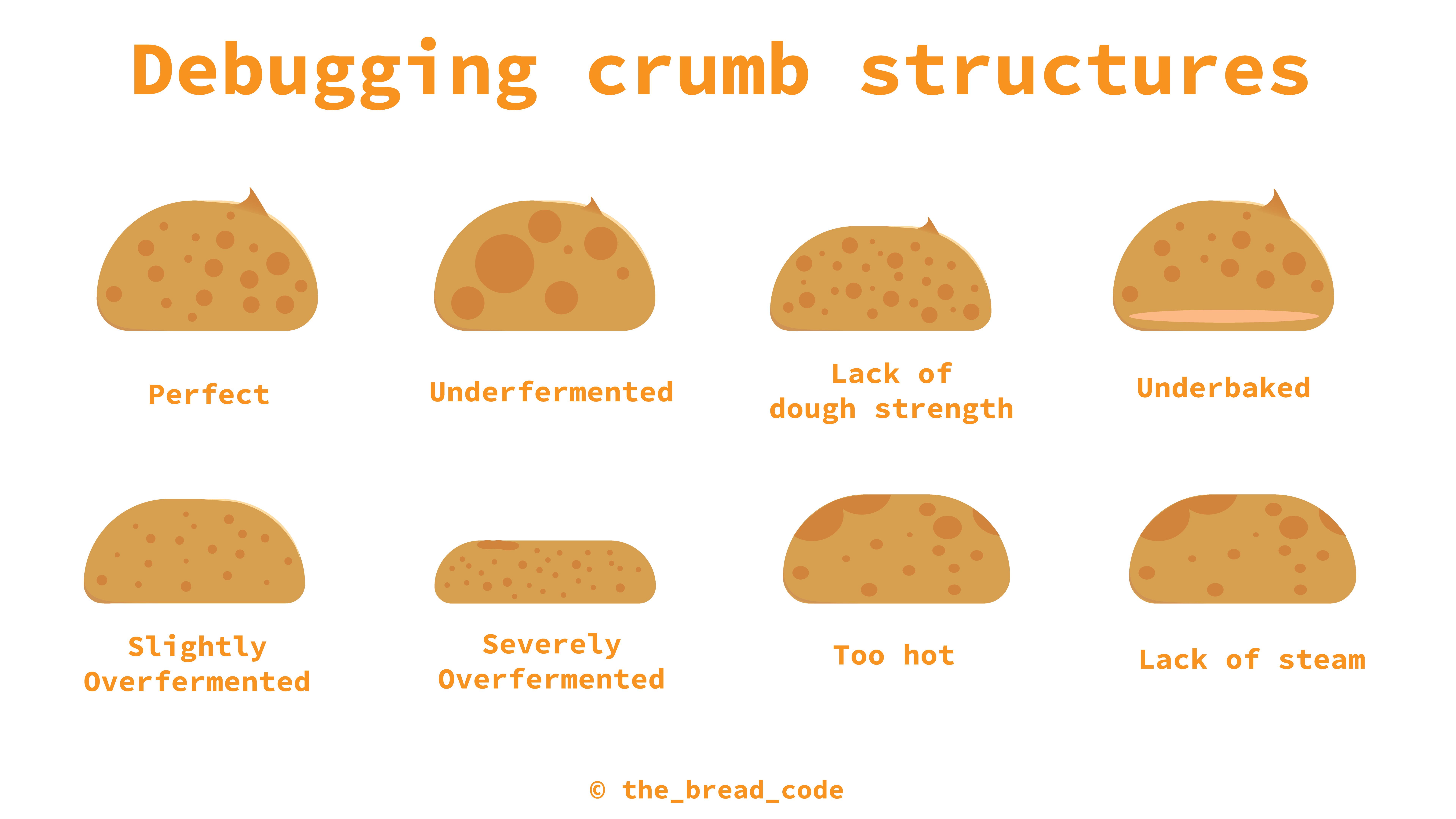Debugging Your Sourdough Crumb
The crumb of your sourdough bread reveals exactly how well you fermented your dough. By debugging and reading your crumb you will learn about common mistakes you might have conducted.
These are the most common mistakes in my opinion. The infographic is part of my free sourdough book. I believe information like this is essential and thus I decided to make the book free. If you like you can donate to keep the project going, but there is absolutely no need! Hope this is helpful.
Please note that this only applies to wheat and spelt sourdough bread.
Perfect
You fermented perfectly on point. Your crumb has even distribution of pockets of air.
Underfermented
Your dough hasn’t been fermented properly. The water evaporates during the bake and creates super pockets of air. Similar to a non leavened pita bread.
Overfermented
Your bacteria ate most of the gluten. The dough can’t hold its structure and stays flat. The longer you ferment the more flat the dough will become eventually. The best solution is to use a loaf pan.
Another option could be that your fermentation was too slow and your flour naturally degraded. This happens often when using whole wheat flour. There are more protease enzymes and thus the flour degrades faster.
Underbaked
Some parts of your crumb are very gummy. The water wasn’t able to evaporate properly.
Sometimes when you ferment for too long the crumb texture becomes a bit soggy and gummy too to some people. This is different though to large unbaked chunks of dough. I personally enjoy this texture a lot.
Too hot
The dough tried to expand but a crust formed too fast. The pockets converge into mega pockets. Try to not bake hotter at 230°C (446°F). Also consider upgrading your steam game.
Lack of steam
This is similar to baking too hot. Your crust sealed too quickly. Your dough couldn’t expand properly. The pockets converge into mega pockets.
The full details and description can be read in the mentioned book in chapter 11. It’s free of charge because I believe information like this should be freely accessible to everyone.
For more information and details please check out chapter 11 in my book “The Sourdough Framework”.
Frequently asked questions on the topic
How do you achieve sourdough oven spring?
To achieve oven spring you need to properly ferment your sourdough bread. The gas and water inside of your dough evaporates during the bake. This rises the dough. When you ferment for too short there is not enough gas. If you ferment for too long your gluten network becomes leaky. The gas and water will evaporate out of your dough. Fermentation is the key to achieve better oven spring.
Why is a sourdough bread flat?
When you ferment a dough for too long most of the gluten has been broken down. The dough can not hold structure. The resulting bread will be flat. The reason for this is the proteolytic activity from the lactic and acetic acid bacteria in your sourdough. They use the gluten as nutrients. Furthermore the protease enzyme contained in your flour converts the gluten into other amino acids. These acids are required for the seed to sprout.
Why are there large pockets of air (alveoli) in my bread?
The reason for this is a too short fermentation. The water evaporates during the bake and creates large pockets of air. Normally the evaporation will be more even, but as there is not enough gas the pockets will converge into a mega pocket. To fix this you need to ferment for a longer period of time or make your sourdough starter more active.
Why is a sourdough sometimes gummy?
This is normal because the bacteria in your sourdough start to break down the gluten. It will be perceived as gummy. If you do not like this, consider reducing the amount of water that you use for your sourdough bread.
Why are there large pockets of air near the crust?
When you bake your sourdough bread too hot or with too little steam a crust forms too quickly. The dough increases vertically in size. The crust prevents further vertical movement and the alveoli will merge into large pockets towards the crust. Reduce the temperature and/or add more steam.
Why is a dutch oven good for baking?
The dutch oven helps to steam your bread during the baking process. This delays crust formation and your bread will be able to spring more in the oven.

